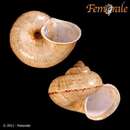en
names in breadcrumbs


Cyclophoridae is a taxonomic family of small to large tropical land snails with an operculum, terrestrial gastropod mollusks in the order Architaenioglossa belonging to the subclass Caenogastropoda (according to the taxonomy of the Gastropoda by Bouchet & Rocroi, 2005).
This diverse family with many species is now limited to the representatives in the tropics and subtropics of the Old and New World.
Their fossil history dates back through the Early Tertiary[1] to the Cenomanian age of the Cretaceous.[2]
The dextral shells are mostly of small and rarely medium size. The form of the shell varies from discoidal to turbinate. The round aperture is often modified, sometimes with an incision or a constriction. The last whorl can sometimes be disconnected and then extends strongly from the winding plane. The operculum is generally circular, which can be retracted deeply into the shell. Its form is multispiral and can be calcified or lacking calcareous overlay. The outer layer of the operculum can contain accessory deposits.
The head of the soft body ends in a short proboscis. The tentacles are round in cross-section, relatively long and taper to the end. The eyes are located at the base of the antenna on flat papillae. The longitudinal muscular foot is not divided. The mantle cavity acts as a lung cavity. The taenioglossan radula has seven elements per transverse row. The central row of the radula contains usually five, rarely three or seven teeth. The animals are dioecious.
This family consists of the following subfamilies according to the taxonomy of the Gastropoda by Bouchet & Rocroi, 2005, which adapted the tribes of Cyclophorinae from the system used by Wenz (1938).[3] Thirty five genera containing approximately 810 species have been recognized as in 2008.[4]
Some notable genera are also listed here:
Cyclophoridae is a taxonomic family of small to large tropical land snails with an operculum, terrestrial gastropod mollusks in the order Architaenioglossa belonging to the subclass Caenogastropoda (according to the taxonomy of the Gastropoda by Bouchet & Rocroi, 2005).
This diverse family with many species is now limited to the representatives in the tropics and subtropics of the Old and New World.
Their fossil history dates back through the Early Tertiary to the Cenomanian age of the Cretaceous.